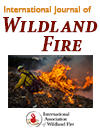International Journal of Wildland Fire
Volume 33
Number 11 2024
Predictions of burn severity and potential post-fire debris-flow from potential wildland fire showed moderate to high hazard classifications for most Colorado River Cutthroat Trout (Oncorhynchus clarkii pleuriticus) conservation populations in the Green and Yampa Rivers of the Upper Colorado River Basin.
Uncrewed aircraft systems coupled with infrared cameras offer notable potential to monitor and measure wildland fire, such as prescribed fires. Here, we test the capabilities of a low-cost UAS to measure fire behaviour and effects. We find that estimates of fire consumption (how much fuel is burned) are notably accurate using this approach.
Integrated landscape management policies have recently been implemented in Portugal, aiming to introduce new practices to improve resilience to fires under climate change. This work co-created with relevant stakeholders presents the evaluation of landscape management scenarios with respect to relative fire hazard reduction under future climate conditions.
This research delves into the flammability properties of Eucalyptus globulus trees during different stages of growth, using experimental and numerical modelling for data validation and prediction purposes. The physical and chemical characteristics of the plants are used in reliable numerical studies to discern the interplay between plant age and flammability.
We use social, economic, and ecological (SES) factors to model building survivorship within the Alaska boreal forest. Buildings close together (<30 m) and high wildfire exposure values were associated with loss, while more higher value buildings on larger lots survived. A comprehensive SES approach is most effective to reduce wildfire risk.
We used 10 different ready-made land cover products to conduct a wildfire exposure assessment for five communities in Alberta, Canada. We compared the results and found differences between datasets and between communities. We discuss the importance of ensuring spatial information is suitable for the application it will be used for.
We measured shoot/whole plant flammability, shoot/leaf morphological traits and leaf nutrient concentrations for 29 vascular plant taxa. While nutrient traits (Mg, K, S, Ca, but not P) were negatively correlated with flammability, these were not as informative as morphological traits (twig dry matter content, retained dead material, moisture content).
This research aims to understand how wildfires on degraded peatlands contribute to greenhouse gas emissions and haze in the atmosphere. The emissions were found to depend on the stage of the fire (from ignition to spread to suppression), the weather conditions and the properties of the peatland.
A wildfire smoke image generation algorithm based on a generative adversarial network (GAN) was designed. A variety of advanced object detection algorithms were trained using the generated data. The experimental results demonstrated that the addition of generated data to real datasets can effectively improve model performance for wildfire smoke detection.
Using a representative survey of Tasmanians’ risk perception and likely behaviour to wildfire threat, we identified four archetypes reflecting a spectrum of responses broadly aligning with gender, age, and income. A longitudinal study (2016–2023) showed increased leave intention, with rural men least likely and urban women most likely to leave.
The Hot-Dry-Windy Index (HDWI) was selected to examine atmospheric conditions aloft, instead of just surface weather. HDWI showed significant differences between spread days and non-spread days on 80 large wildland fires in Alberta, Canada. We also identified a minimum forecast timeframe of 16:00–19:00 hours MDT for its application, and three climatologies for context.
Grassland wildfire severity peaked in areas with high fuel content and on steep slopes facing into the wind. Plant production recovery increased with higher fire severity and recovery was generally higher on sites with lower potential productivity.
Tragedy incidents and land management agency initiatives have influenced the creation and evolution of wildland firefighter safety policies and practices. External factors including sociodemographic, material, political, and socio-environmental factors also matter a great deal. Understanding these external factors is essential for improving safety outcomes for firefighters.
Multiple factors have been found to have an influence on the response time of helitack teams on new wildfire starts in Quebec, Canada. Findings highlight the potential for policy adjustments to improve response efficiency, both for getaway time and travel time.





